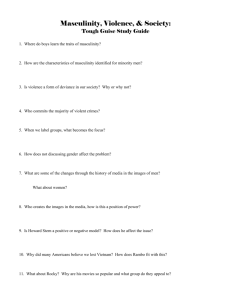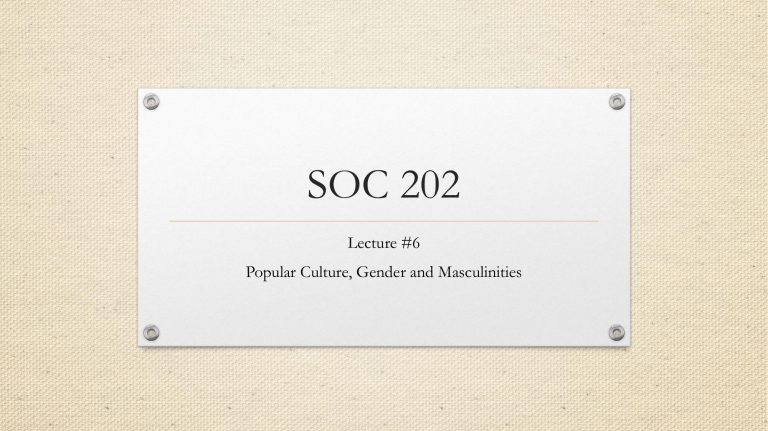
SOC 202 Lecture #6 Popular Culture, Gender and Masculinities SOC 202 Part ONE – Gender & Hegemonic Masculinity Hegemonic Masculinity • By definition Hegemonic masculinity is represented through: • Dominant definitions of masculinity embedded in social institutions such as the state, education, the family, religion, and popular culture. • For example, PM Trudeau, his beard and the state as a leader • Male power as not simply held by individual men but institutionalised in social structures and ideologies that support the gender order in favour of men • For example: the “old boys club” or “boys will be boys” 3 Hegemonic Masculinity con’t • If institutionalized, masculinity is also open to contestation & • • • • challenge For example, men are not only organised through hierarchy in relation to women, but also in relation to each other as well For example: In terms of privilege, marginalisation, “respect” in the workplace, success with women, as well as occupying and avoiding positions of subordination with regards to other men. Recall Patrick and Louis in American Psycho 4 Hegemonic Masculinity con’t still • HM allows for resistance (challenge) through men who are subordinated or marginalised by the hegemonic: that is masculinity is socialized as a negotiation predicated on coercion and consent and masculinities can challenge the dominant • For example: • Traditionally, gay men have had a subordinate relationship to hegemonic models of masculinity while constituted as effeminate, feminine etc. 5 Michel Foucault, On Gender • Michel Foucault (The History of Sexuality) • Gender as a Model of Inscription: • Meaning: this doctrine argues we are formed by internalizing disciplinary structures that are normalized from birth – blue or pink, to be very simple • For Foucault, he sees us as being complicit to socialized gender constructs while aware of the social punishment or consequences should we shift outside SOC 202 Part TWO – Situating Masculinity in Media Popular Media and Masculinity • The Media and the Models of Masculinity (Mark Moss, 2011) • Moss provides a historical account of how various models of masculinity are “conditioned, defined, or illustrated by different media” • That is, the models of masculinity mainstream media circulate have an enormous influence on men and boys who mimic the dress, behavior, and mannerisms of key archetypes • For example, a desire to “fit in” or “one of the boys” etc… Media and Masculinity • Moss rationalizes mainstream media as pedagogic (teaching) and states: • “media is the single most authoritative force in conveying opinion and offer a barometer of what is going on” and define the varieties of a masculine experience. • For Moss, various historical periods and events have affected the models of masculinity in the media. For example, war, feminism, the economy in the 20th century and 9/11, identity politics, and (in)security in the 21st century SOC 202 Part THREE – The Body on Display Visual Pleasure and Narrative Cinema • As Mulvey argued: • Voyeuristic visual pleasure is produced by looking at another, whereas narcissistic visual pleasure can be derived from self-identification with the figure in the image. • Mulvey argues: • (a) both voyeurism and narcissism are gendered. • (b) in pop culture, the spectator has historically been positioned to identify with the male look as the camera films from the point of view of the male character On Mulvey: Criticism & Limitations • Laura Nussbaum (1995) • (a) Mulvey’s arguments “on gender and the body are complex but objectification need not only and always be regarded as negative” • (b) “Objectification may be a feature of sexual desire without necessarily implying oppression” On Mulvey: Criticism & Limitations • Nussbaum con’t: • (c) For some “without objectification there can be no desire, and without subjectification of that objectification there can be no pleasure.” • (d) “central to female interpretations of images of other females is polysemy, identification and self, contextual meanings and connotations” • For example, recall Rubin’s ideas on sex, deviance and categorization Mulvey Criticism & Limitations • Nussbaum con’t • Female viewers often seek “a deconstruction of classical visual and narrative codes and seek conventions could allow for an exploration of female subjectivity, gaze, and desire” • Gradually, female filmmakers and viewers develop a new framework within popular cinema in which new codes and forms of visual and narrative pleasure are constituted as “through her gaze” SOC 202 END OF LECTURE
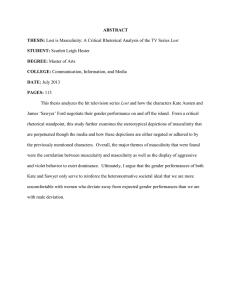
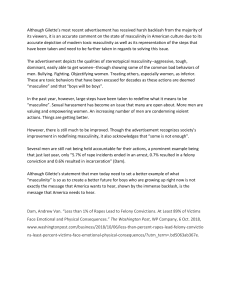
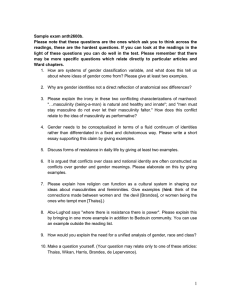
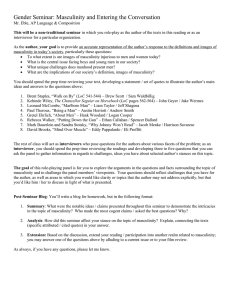
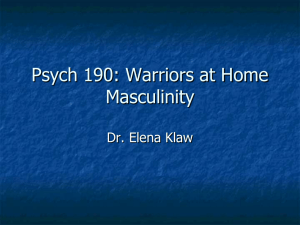
![C-SWIR Seminar Promo: 26oct2015 [DOC 143.50KB]](http://s2.studylib.net/store/data/014974093_1-9ff6fa79b7dfcfba164f1f275834567b-300x300.png)
